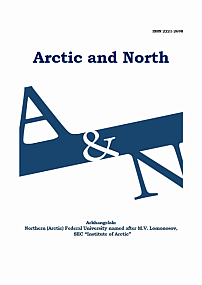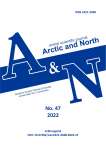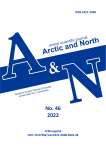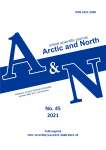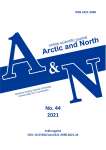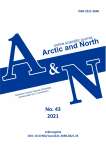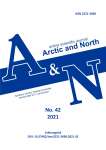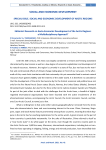Arctic and North
Indexing of the journal “Arctic and North”: EBSCO Publishing, USA, Directory of Open Access Journals — DOAJ, Global Serials Directory Ulrichsweb, USA, NSD, Norway, InfoBase Index, India, ERIH PLUS, Norway, MI-AR, Spain, OAJI, RSCI based on Web of Science. The journal is issued not less than 4 times a year.
The journal “Arctic and North” (also known as “Arktika i Sever”) is registered at Roskomnadzor (Federal Service for Supervision in the Sphere of Telecom, Information Technologies and Mass Communica-tions) as an online media published in Russian and English: Registration certificate ЭЛ No. ФС77- 78458, issued on the 8th of June 2020. Earlier, the journal was registered as an electronic periodical, certificate ЭЛ No. ФС77-42809 dated November 26, 2010
The journal is designed for professionals and a wide range of readers, both in Russia and abroad; it is issued both in Russian and English (translated by the Editorial staff).
The journal is focused on the results of studies, research papers, reviews, etc. joined by the Arctic or Northern theme, in following areas of knowledge:
- Economics;
- Social studies;
- Political science.
The Editorial Board of “AaN” is committed to the policy of openness and accessibility. Since September 2016, the journal has CC BY-SA license. All articles are checked by the Antiplagiat system. The service is designed to check text documents for borrowings.
The policy of "Arctic and North" helps to ensure that published articles and reviews are in demand for research, PhD dissertation, state and municipal management, policy making and the development of the northern regions.
Northern (Arctic) Federal University named after M.V. Lomonosov
Выпуски журнала
Статьи журнала
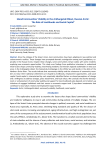
Статья научная
Since the collapse of the Soviet Union, local communities have been adapting to new political and socioeconomic realities. These changes have prompted dramatic outmigration among rural populations, es-pecially in the Russian Arctic. Despite these changes, some communities remain viable, with some residents exploring new economic opportunities. This study uses findings from qualitative interviews to understand what factors shape community viability, interviewing residents and relevant regional stakeholders in two case areas in the Arkhangelsk oblast: the Solovetsky Archipelago in the White Sea and islands in the delta of the Northern Dvina River. The results indicate that community viability and the reluctance of community mem-bers to leave their traditional settlements are shaped by livelihoods, employment opportunities, and social capital. Social capital is characterized by such empirically identified factors as shared perceptions of change and a willingness to address changes, place attachment, and local values. We conclude that further develop-ment or enhancement of community viability and support for local livelihoods also depends on 1) bottom-up initiatives of engaged individuals and their access to economic support and 2) top-down investments that contribute to local value creation and employment opportunities.
Бесплатно
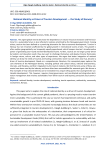
National identity as driver of tourism development - the study of Norway
Статья научная
The urgent global need to decrease the dependence on natural resource extraction and find solutions for a sustainable future is also reflected in policies prioritized by the Norwegian government. Among others, tourism has been defined as a promising alternative for future economic development. Tourism in Norway has not remained unaffected by the global growth in international tourist arrivals. This growth is often neither geographically nor temporally equally apportioned, which hampers tourism’s transformative power of generating year-round and well-distributed income. Further, tourists are no longer purely driven by hedonic and relaxation needs: they also want to challenge themselves and deeply immerse themselves in foreign nature, culture, and other types of experiences. We argue that better integration of national identity can draw the needs of tourists and hosting communities nearer to each other and, thus, become a driver of tourism development. Based on a comprehensive literature, this conceptual paper explores the core elements of the Norwegian identity, including political and cultural values, national characteristics, interests, and lifestyles, and their integration by the tourism industry. We find that only some of these elements have been used by the industry and have often been commodified for economic gain. We discuss a few examples of how national identity can be translated into unique selling points that could generate sustainable development. This, however, requires strong governance, and coordinated and integrative destination management that involves stakeholders from within tourism and beyond, particularly local communities.
Бесплатно
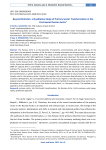
Статья научная
The Russian Arctic is at the epicentre of economic, environmental, and social changes. At the same time, the peripheral character of the territory, its strong orientation on primary sector makes the region extremely volatile to suchlike shifts. The study concerns primary sector transformation in the Post-Soviet period when after 1991 significant changes in the economy were observed. The main aim of the paper is to identify the specifics, features and development prospects of the recent primary sector transformation in the Russian Arctic. The statistical methods do not reflect the full picture of the transformation. Firstly, Russia has switched to UN national accounts system only in 1994. Secondly, the Arctic statistics after 2009 for regional level is unavailable. That is why the main method of the research is the expert survey method. The results of the study demonstrate the dominant role of the primary sector and the strong dependence of Russian Arctic regions on these activities. The study identifies the key factors and drivers of the transformation, a specific position of the oil and gas sector and the role of natural resources to be traditionally used in the primary sector. Despite the positive role of economic diversification in the long-term economic development, the corresponding effect for the Arctic regions is not fully expressed. The methodological novelty of the research is an unconventional research method of investigating primary sector transformation on the regional level in the Post-Soviet Russian Arctic, i.e. the expert survey. The method can be applied to other countries and industries.
Бесплатно
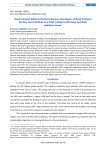
Статья научная
This paper contributes to filling a knowledge gap by presenting new research within the practical field of road transport. It takes the buyers of road transport services as its point of entry and seeks to answer the follow question: How can buyers of road transport services contribute to safe road transport in northern Norway? A qualitative approach was selected for this study, and semi-structured interviews were conducted with six different buyers of road transport services. By using a modified version of The Pentagon Model, different aspects were analyzed in order to identify organizational characteristics and qualities that will improve the possibility for buyers of road transport to contribute to a safer road transport in Northern Norway and thereby contribute to fewer accidents and near-misses. The following characteristics and qualities were identified: 1) the importance of developing a detailed formal contract with the provider of road transport; 2) being aware of the possibilities with new technologies; 3) understanding that the decision criteria for ordering transport can influence road transport safety; 4) seeing the importance of good communication with both the transport organization and the authorities; 5) recognizing that knowledge of and trust in a transport organization is important but could also affect judgement regarding revisions and controls. This study suggests that buyers of road transport services can contribute to a safer road transport in northern Norway by emphasizing these five characteristics and qualities.
Бесплатно
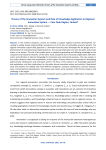
Статья научная
In the northern periphery, actions are needed to support regional economic development. According to widely shared understanding, innovations are at the core of sustainable economic growth. The regional innovation system (RIS) approach is a framework that has been developed for the design and implementation of innovation-based regional policies. This concept implicates new roles for public and private actors in the system. The role of the public sector is related to generating and diffusing knowledge to the companies and industrial networks. On the other hand, companies have increased collaboration with other actors and utilization of external knowledge for innovation and commercial purposes. The case analysis in this study is based on data from experiments in Oulu region, Finland, which has a long history in developing public-private collaboration and innovation system. The focus of the analysis is on knowledge application and exploitation, and their implications for the public driven innovation system and activities. Operational tools and activities are divided into three different categories: company collaboration, business development, and competence development. The analysis also reveals some examples of the future prospects and challenges in the region.
Бесплатно

